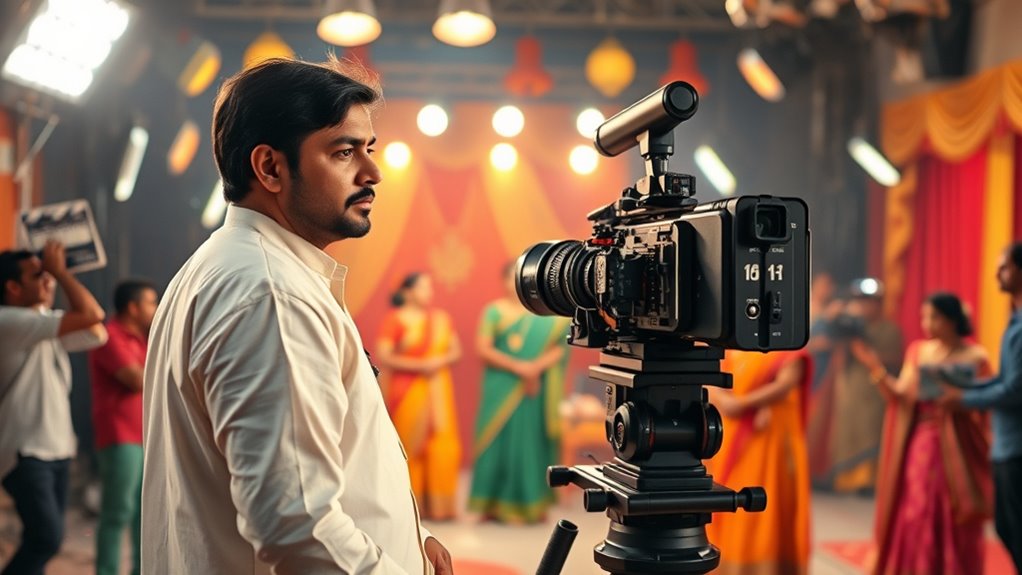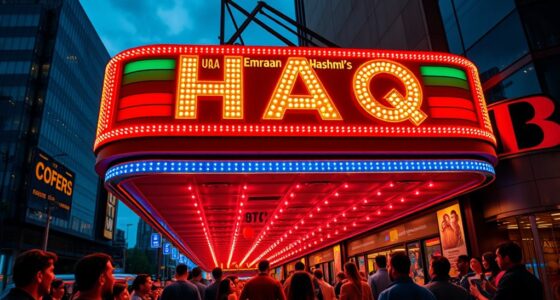On a typical day, you start with reviewing scripts and collaborating with writers to refine scenes. Then, you oversee location scouting, set design, and coordinate your team for rehearsals and blocking. As shooting begins, you manage camera angles, lighting, and performances, ensuring everything aligns with your creative vision. You also communicate constantly with the crew to handle scheduling and technical details. Stay with us to explore how every step brings the story vividly to life behind the scenes.
Key Takeaways
- The director collaborates with the cinematographer to plan actor movements, camera angles, and scene blocking using storyboards or floor plans.
- They oversee rehearsals to build actor chemistry, clarify scene progression, and refine performances through feedback and improvisation.
- The director conducts technical checks, coordinates with crew for lighting, camera setup, and ensures all equipment and props are ready.
- During filming, they monitor performances, coordinate scene takes, and make quick decisions to maintain continuity and scene quality.
- Post-shoot, the director reviews footage with editors, providing feedback to shape the final cut and ensure creative vision is achieved.
Pre-Production Planning and Script Revisions

Pre-production planning and script revisions form the foundation of any successful Bollywood film, ensuring that the story is compelling and ready for filming. You’ll begin with initial script drafts, often created by multiple writers or specialists in dialogue and screenwriting. These drafts go through multiple rounds of edits and revisions, guided by feedback from producers, directors, and creative heads. As the script evolves, it considers genre requirements, audience expectations, and the overall creative vision. Storyboarding and script breakdowns help you visualize the narrative before shooting begins, making sure every scene fits seamlessly. During this phase, securing legal clearances for story rights and copyrights is essential. This thorough preparation helps set a solid foundation, ensuring a smoother progression into production. Additionally, the screenplay development process often involves collaboration with the entire creative team to refine the narrative and character arcs, ensuring consistency and depth throughout the story. Incorporating feedback from creative reviews can further enhance the script’s effectiveness and emotional impact. Moreover, effective pre-production planning plays a crucial role in managing resources and timelines efficiently during filming. Paying close attention to initial script drafts can also help identify potential challenges early, such as budget constraints or logistical issues, saving time and resources later in production. Recognizing sound design and auditory elements early in planning can improve the overall cinematic experience and emotional resonance of the film.
Location Scouting and Set Design Coordination
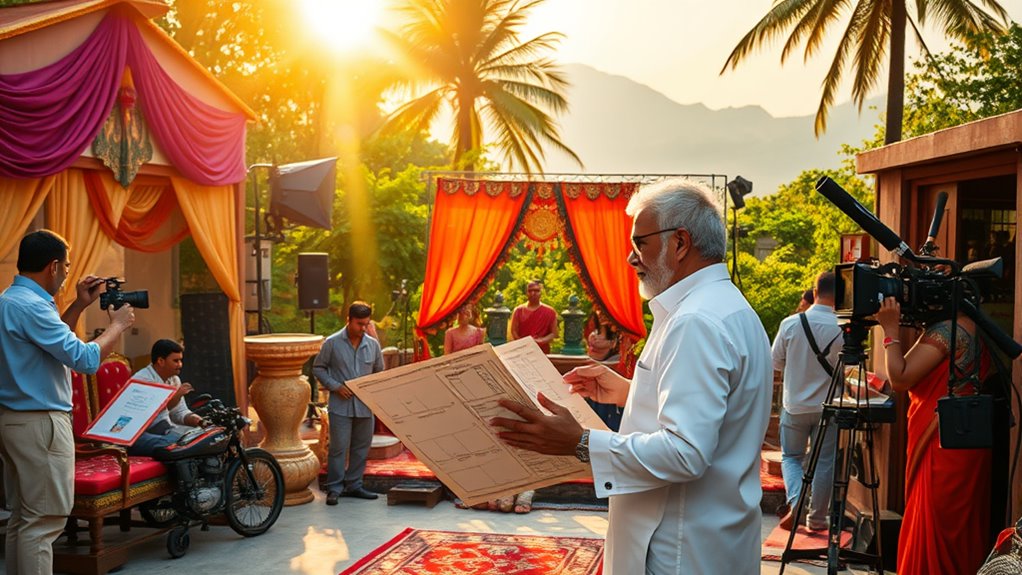
You begin location scouting by aligning the chosen settings with your film’s genre and tone, guaranteeing that each site visually supports the story you want to tell. For horror, you look for eerie, abandoned areas; for romance, vibrant, lively spots. Maintaining tone consistency is crucial—dramatic scenes may need somber, isolated locations, while adventure scenes call for expansive landscapes. You rely on detailed descriptions from your team to guide your choices, helping you avoid mismatches that could confuse viewers. Efficient genre alignment saves time and resources, reducing reshoots and post-production fixes. You also consider how locations reinforce themes, like remote areas for isolation, and how they fit with your visual narrative. Additionally, understanding small mistakes in location selection can prevent larger issues during filming. Recognizing the importance of location suitability ensures that your chosen sites contribute positively to your film’s overall quality and coherence. Practical considerations, such as accessibility and safety, are evaluated thoroughly to prevent disruptions during shooting. A thorough assessment of each location’s suitability ensures that practical considerations do not hinder your creative vision. Moreover, assessing the environmental impact of your chosen sites can help maintain sustainability standards and avoid potential legal issues. Incorporating knowledge about appliance maintenance plans can also be useful if filming requires specialized equipment that needs regular upkeep during long shooting schedules.
Assembling the Crew and Budget Management
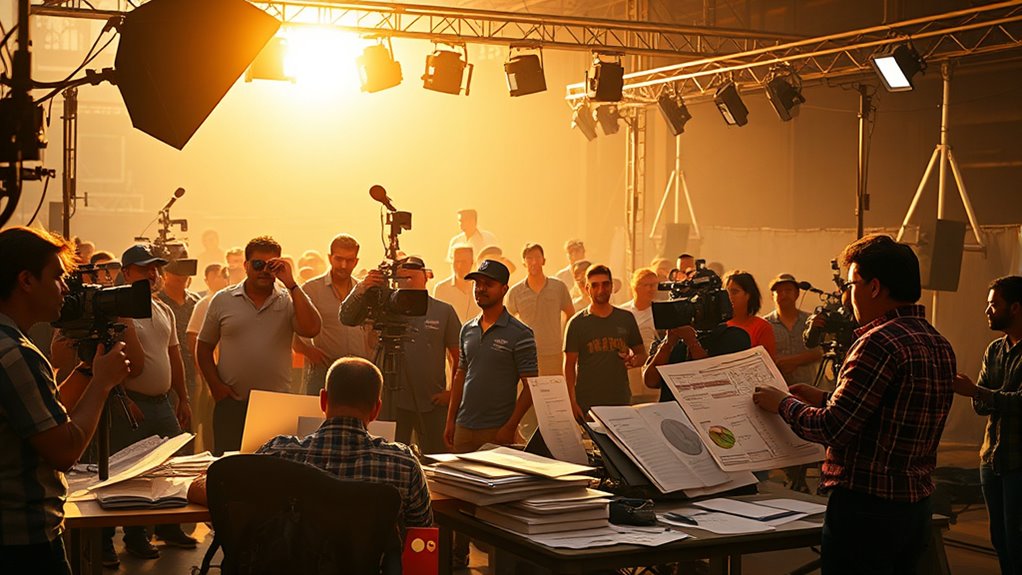
Once the locations are finalized, assembling a skilled crew becomes the next priority. You’ll work closely with your team, including producers, camera operators, and department heads, to guarantee everyone understands their roles. Building a cohesive team is crucial so all elements align with your vision. Understanding the hierarchy helps you delegate tasks efficiently. Clear communication keeps everyone on the same page. To streamline this process, focus on:
- Selecting specialists like costume designers and effects supervisors to bring your vision to life.
- Defining roles clearly to avoid confusion during shooting.
- Maintaining open channels for ongoing updates and feedback.
- Ensuring compliance with copyright and licensing regulations to protect your production.
Additionally, choosing the right electric bike conversion kits can facilitate quick transportation around filming locations, helping to improve logistical efficiency. Simultaneously, you’ll manage the budget by allocating funds wisely, controlling costs, and planning for unexpected expenses. Efficient scheduling and resource use help stay within financial limits while maintaining quality.
Rehearsals and Actor Direction

During rehearsals, you focus on building actor chemistry and coordinating their movements to make certain seamless scenes. You guide actors through blocking and help them deepen their on-screen relationships, making sure their interactions feel natural. By fine-tuning these elements, you create a scene that’s both authentic and visually compelling. Additionally, rehearsals provide an opportunity to clarify scene progression and ensure the actors are comfortable with their spatial positioning before filming begins.
Actor Chemistry and Chemistry
Building genuine chemistry between actors hinges on effective rehearsals and skillful direction, which help them understand and connect with their characters and each other. During rehearsals, you see actors:
- Develop trust through off-screen interactions and character studies, increasing authenticity.
- Use improvisation and active listening to deepen their connection and discover new dynamics.
- Receive targeted feedback from directors, fine-tuning performances to enhance on-screen chemistry.
- Incorporate diverse rehearsal techniques like script analysis and workshops, which play a crucial role. As a director, you create a supportive environment that encourages openness and experimentation. By fostering trust and providing clear guidance, you help actors build natural chemistry, making their romantic or emotional scenes believable and compelling. Paying attention to actor chemistry during rehearsals can significantly elevate the emotional impact of a scene.
Blocking and Movement Coordination
Effective rehearsals are the backbone of successful blocking and movement coordination on set. You collaborate with the cinematographer to plan actor positions and movements, often using storyboards or floor plans for macroblocking. These big-picture movements establish actor trajectories, influence shot composition, and communicate character relationships. During rehearsals, you focus on macroblocking first, refining timing and positioning, then layer in microblocking—small gestures and precise timing—to enhance character dynamics. You give actors clear instructions and feedback to make movements feel natural and support storytelling. Coordination with the crew ensures camera angles and lighting complement actor movements. Proper blocking minimizes retakes and boosts scene coherence, allowing performances to flow seamlessly and visually reinforce narrative themes and power dynamics. Additionally, well-planned blocking can improve the overall visual harmony of the scene, making it more engaging for the audience. Incorporating zodiac compatibility insights can help directors understand actors’ personalities better, fostering a more collaborative and harmonious rehearsal process. Furthermore, understanding dog names can inspire creative ways to assign character traits or nicknames during rehearsals, subtly enhancing performances. Recognizing lighting techniques and how they interact with blocking also helps in achieving the desired mood and focus within each scene. Being aware of entertainment support hours can help schedule rehearsals efficiently, ensuring all team members are available when needed.
Shooting Schedule and On-Set Management
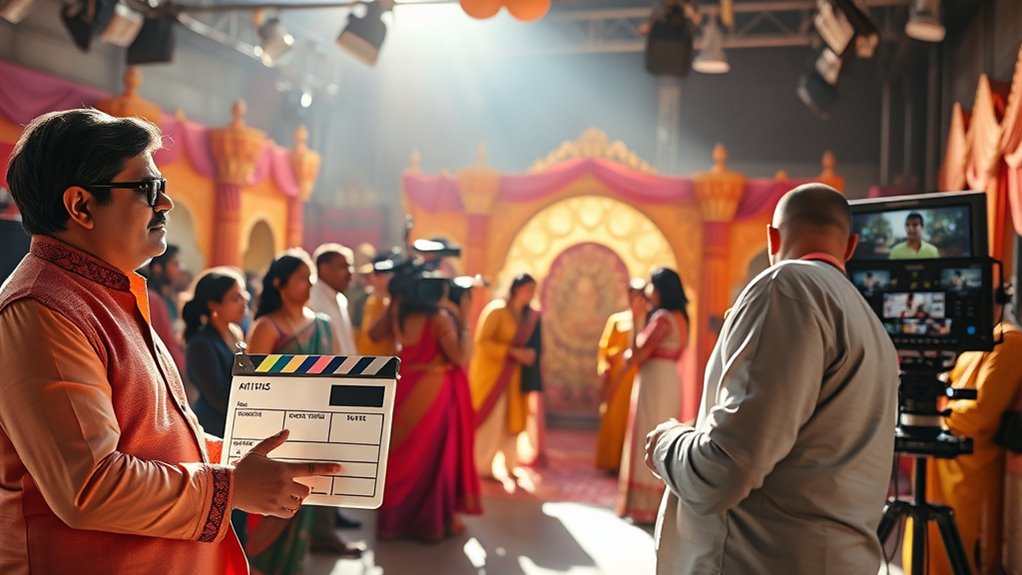
As a director, managing the daily shooting timeline and coordinating your on-set crew are essential for staying on track. You need to keep everyone aligned and ready to adapt when unexpected delays pop up. Efficient handling of these elements keeps production smooth and helps meet tight schedules. Familiarity with self-watering plant pots can serve as a metaphor for maintaining optimal conditions on set, ensuring that all aspects are well-managed and resilient to disruptions.
Daily Shooting Timeline
A well-organized shooting schedule is essential to keep a Bollywood production running smoothly. Your day begins with a call sheet, which outlines roles, tasks, and timings for everyone. You then guarantee all equipment—cameras, lights, microphones—is set up and ready before filming starts. As the director and director of photography finalize camera positions, actors rehearse their scenes, focusing on blocking and performance. To stay on schedule, you:
- Coordinate scene takes and ensure multiple cameras are ready for efficiency
- Monitor actor performances and adjust based on director’s feedback
- Communicate with assistants to maintain discipline and track progress
- Check the gear setup to ensure all technical components are functioning correctly before shooting begins
- Keep an eye on security measures to prevent unauthorized access and safeguard equipment during breaks
- Regularly inspect the electric heated mattress pads used on-set, especially for comfort during long shooting hours, to ensure safety and proper functioning
If delays occur, you’re prepared to reschedule scenes or cut shots, keeping the shoot on track within the planned days. Constant communication and flexibility are key to a smooth daily timeline.
On-Set Crew Coordination
On-set crew coordination is the backbone of a smooth shooting day, ensuring everyone works together seamlessly. You’ll find the director working closely with assistant directors, cinematographers, and production managers to keep things on track. Assistant directors manage the schedule, making sure scenes are shot on time and actors are ready. The script supervisor keeps tabs on continuity, alerting the team to missing shots or coverage gaps. Meanwhile, the production manager handles logistics, coordinating crew, equipment, and locations. Daily call sheets and briefings keep everyone aligned, while real-time communication tools like walkie-talkies ensure quick updates. Scene schedules are carefully planned to optimize location and resource use, with contingency buffers built in to handle minor delays, keeping the shoot running smoothly.
Handling Unexpected Delays
Unexpected delays can disrupt even the most carefully planned shooting schedules, so it’s essential for Bollywood directors to stay adaptable and proactive. When unforeseen issues arise—like geopolitical tensions, weather problems, or technical setbacks—you need a clear plan. First, evaluate the situation quickly and identify priority tasks. Second, communicate transparently with your team about adjustments. Third, implement contingency plans, such as rescheduling scenes or shifting locations. Managing delays involves juggling multiple factors, from coordinating with producers to adjusting shooting timelines. Staying flexible allows you to minimize downtime and keep the production on track. Remember, delays are inevitable, but how you handle them determines the overall success of your project. Your quick thinking keeps the crew motivated and the film moving forward.
Filming Techniques, Camera Angles, and Lighting

Filming techniques, camera angles, and lighting are essential tools a Bollywood director uses to craft compelling visuals and evoke emotions. You might use multi-camera editing to create dynamic, visually stunning sequences or slow-motion to emphasize dramatic moments. Underwater filming adds depth to romantic scenes, while drones capture breathtaking aerial views. Steadicams ensure smooth tracking shots that follow characters seamlessly. Camera angles like low angles emphasize power, while high angles convey vulnerability. Close-ups focus on emotions, and wide shots establish setting. Lighting choices, such as natural light for authenticity or artificial light for mood, shape the scene’s tone. High-key lighting creates an uplifting feel, while low-key adds mystery. These techniques work together to immerse audiences and bring your vision vividly to life.
Post-Production Collaboration and Editing
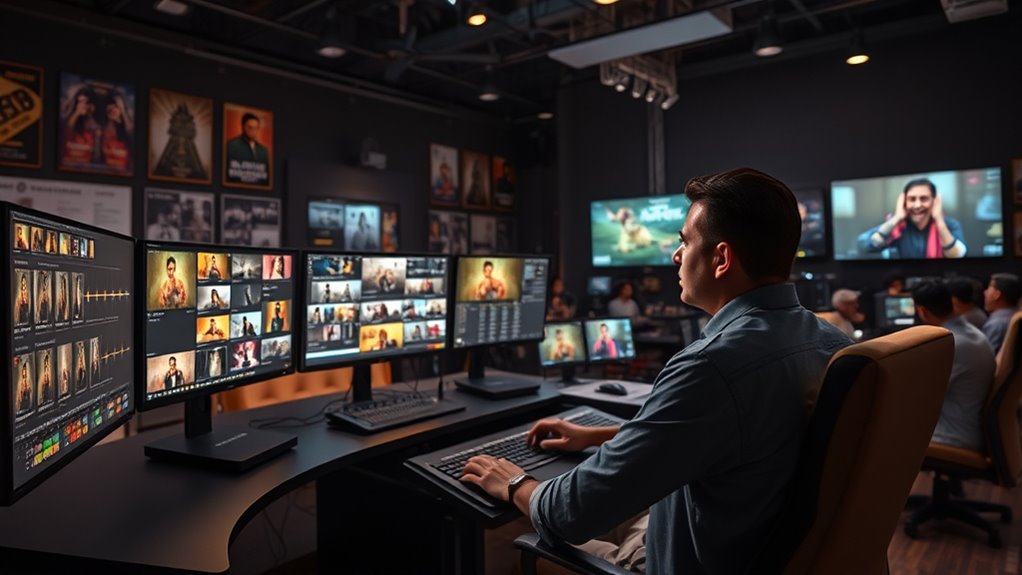
Post-production begins once principal photography wraps up, marking the final stage of shaping your film’s story and emotional tone. During this phase, you’ll work closely with the editor to craft the narrative. You’ll review initial rough cuts and guide refinements through feedback loops, ensuring the story flows smoothly. To succeed, focus on these key steps:
- Collaborate with your editor to establish the desired tone and pacing.
- Analyze the script and selected shots to enhance storytelling.
- Make final decisions on edits, combining creative input and technical precision.
Using software like Avid, Adobe Premiere, or Final Cut Pro, you’ll refine picture, sound, and color. This process transforms raw footage into a polished, emotionally compelling film ready for audiences.
Promotional Strategies and Distribution Planning
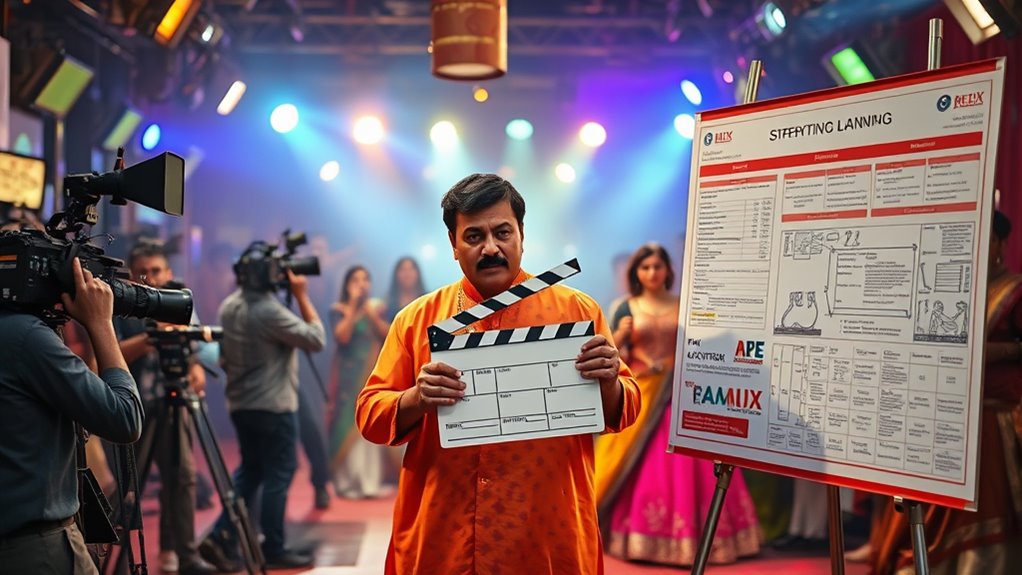
Effective promotional strategies and thorough distribution planning are essential to ensuring your film reaches its target audience and maximizes revenue. You start by conducting market research to identify key demographics, genre preferences, and regional appeal. Analyzing box office trends, release windows, and competitor films helps you choose the most suitable timing. Pre-release tactics like trailer launches, social media campaigns, and influencer partnerships generate buzz, while press events and star appearances boost anticipation. You license theatrical rights to distributors, often segmenting rights by region or language to tailor your approach. Collaborating with exhibitors ensures effective scheduling and local promotions. After the theatrical run, you expand revenue through digital streaming, TV rights, and international sales, ensuring your film finds its widest possible audience.
Frequently Asked Questions
How Do Directors Handle Creative Differences With Producers?
When you face creative differences with producers, you should communicate openly to clarify your vision and understand theirs. You might negotiate compromises on minor details while standing firm on major creative choices. Mediation can help resolve conflicts, and documenting agreements prevents misunderstandings. Staying flexible and respectful keeps the atmosphere professional, allowing you to work through disagreements effectively. Ultimately, balancing your creative passion with producer concerns leads to a stronger final film.
What Are the Most Common On-Set Emergencies Faced Daily?
You face daily on-set emergencies like injuries, equipment malfunctions, and safety hazards. Accidents happen, so you must act quickly to guarantee everyone’s safety. Weather changes can delay shoots, and technical issues may halt filming unexpectedly. You also handle logistical hiccups like transportation problems or location permit delays. Staying calm, quick-thinking, and prepared helps you manage these emergencies efficiently, keeping the production on track.
How Does a Director Maintain Actor Motivation During Long Shoots?
Ever wondered how a director keeps actors fired up during those marathon shoots? You stay connected through clear instructions and detailed blocking, ensuring actors feel confident and in control. You also share inspiring stories and emphasize resilience, fueling their passion. Breaks are your secret weapon—strategically timed to recharge their energy. By fostering respect and collaboration, you create an environment where motivation thrives, even amidst fatigue and long hours.
What Is the Role of Technology in Enhancing Storytelling?
Technology plays a vital role in enhancing storytelling by enabling you to create stunning visuals, realistic effects, and immersive worlds. VFX allows you to depict scenes impossible in real life, adding cultural depth and global appeal. Digital platforms help you reach wider audiences and gather insights to tailor your stories. Emerging tools like AI and virtual production boost creativity, streamline workflows, and reduce costs, making your storytelling more innovative and compelling.
How Are Final Decisions Made During Post-Production Edits?
You make final decisions during post-production through a collaborative process involving the director, editor, and producers. You review multiple versions—rough cut, fine cut, and final cut—adjustting pacing, narrative, and visuals based on test screenings and feedback. You rely on technology like digital intermediate tools to refine color and effects, while considering logistical, budgetary, and strategic factors. You balance artistic vision with commercial goals, ensuring a cohesive, market-ready film.
Conclusion
Just like a master storyteller shaping a legend, your day behind the camera reveals how each scene and decision crafts the magic of Bollywood. Every moment on set echoes the artistry of a director’s vision, transforming raw footage into a cinematic masterpiece. Remember, as in all great tales, it’s the passion and precision you bring that turn dreams into unforgettable realities, leaving audiences captivated long after the credits roll.
